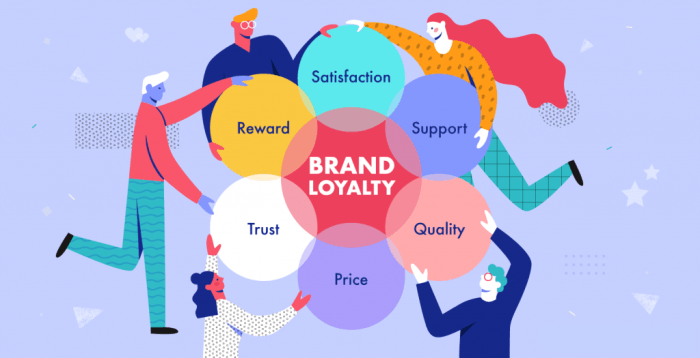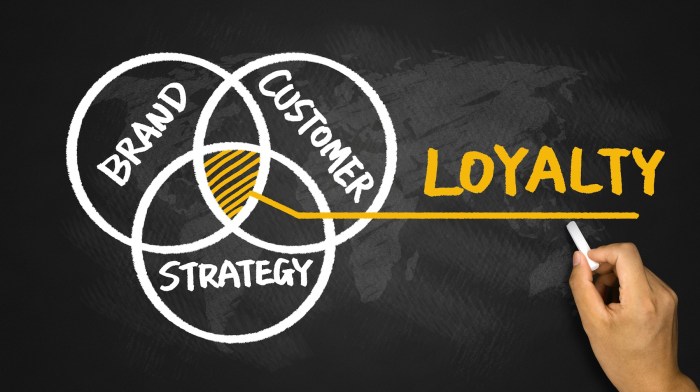Building Brand Loyalty starts with creating strong connections between customers and your brand, leading to long-term success and growth. From engaging storytelling to personalized experiences, this topic explores various strategies to foster brand loyalty effectively.
Importance of Building Brand Loyalty
Building brand loyalty is essential for long-term success in today’s competitive market. When customers are loyal to a brand, they are more likely to make repeat purchases, recommend the brand to others, and withstand price increases. This leads to increased customer retention, higher profitability, and a stronger market position.
Examples of Companies Excelling in Brand Loyalty
- Apple: Known for its loyal customer base who eagerly anticipate new product releases and upgrades.
- Nike: Builds brand loyalty through innovative products, celebrity endorsements, and engaging marketing campaigns.
- Starbucks: Fosters loyalty by creating a unique customer experience, personalized rewards program, and community engagement initiatives.
Impact of Brand Loyalty on Customer Retention and Profitability
- Customer Retention: Brand loyal customers are more likely to continue purchasing from a company, reducing the need for costly acquisition of new customers.
- Profitability: Loyal customers tend to spend more, be less price-sensitive, and contribute significantly to a company’s bottom line.
- Word-of-Mouth Marketing: Loyal customers are more likely to recommend the brand to others, leading to organic growth and increased market share.
Strategies for Building Brand Loyalty

Building brand loyalty requires a combination of different strategies to engage customers, create personalized experiences, and offer loyalty programs that keep them coming back for more. Storytelling and emotional connections play a crucial role in enhancing brand loyalty, while social media serves as a powerful tool for building and maintaining relationships with customers.
Customer Engagement
Customer engagement is key to building brand loyalty. By interacting with customers through various channels such as social media, email campaigns, and personalized messaging, brands can create a sense of community and connection with their audience. This engagement helps to build trust and loyalty over time.
Personalized Experiences
Offering personalized experiences to customers can make them feel valued and appreciated. By collecting data on customer preferences and behavior, brands can tailor their products and services to meet individual needs, creating a unique and memorable experience that encourages repeat business.
Loyalty Programs
Loyalty programs incentivize customers to continue purchasing from a brand by offering rewards, discounts, or exclusive offers. These programs not only encourage repeat purchases but also foster a sense of belonging and exclusivity among loyal customers, strengthening their bond with the brand.
Storytelling and Emotional Connections
Storytelling allows brands to connect with customers on a deeper level by sharing their values, mission, and history. By creating emotional connections through compelling narratives, brands can evoke feelings of trust, loyalty, and authenticity, ultimately building a strong bond with their audience.
Social Media, Building Brand Loyalty
Social media plays a vital role in building and maintaining brand loyalty by providing a platform for brands to engage with customers in real-time, share updates and promotions, and gather feedback. By actively participating in conversations and building relationships on social media, brands can create a loyal following of engaged customers who advocate for their brand.
Benefits of Brand Loyalty
Building brand loyalty comes with a host of benefits that can significantly impact a business’s success and growth. Loyal customers not only generate repeat business but also act as brand advocates, spreading positive word-of-mouth and contributing to the brand’s sustainability.
Advantages of Having a Base of Loyal Customers
- Loyal customers are more likely to make repeat purchases, increasing revenue and profitability.
- They are less price-sensitive and more willing to pay a premium for products or services.
- They provide valuable feedback and insights, helping the brand improve and innovate.
Positive Word-of-Mouth Marketing
- Happy and satisfied customers are more likely to recommend the brand to friends, family, and colleagues.
- Word-of-mouth marketing is powerful and cost-effective, reaching a wider audience through personal recommendations.
- Positive reviews and recommendations from loyal customers can build credibility and trust for the brand.
Contribution to Brand’s Sustainability and Growth
- Loyal customers provide a stable revenue stream, reducing the impact of market fluctuations.
- They are more forgiving of occasional mistakes or issues, giving the brand a second chance to make things right.
- Repeat business from loyal customers helps in building a strong foundation for long-term growth and success.
Measuring Brand Loyalty

Brand loyalty is a crucial aspect of any business’s success, but how do you measure it effectively? Let’s dive into key metrics and strategies that can help gauge brand loyalty.
Net Promoter Score (NPS)
The Net Promoter Score (NPS) is a widely used metric to measure customer loyalty. It involves asking customers a simple question: “How likely are you to recommend our product/service to a friend or colleague?” Based on their responses, customers are categorized as Promoters, Passives, or Detractors. Calculating the NPS gives you an overall indication of customer loyalty and satisfaction.
Customer Retention Rate
Customer retention rate is another important metric to measure brand loyalty. It shows the percentage of customers that continue to do business with you over a specific period. A high customer retention rate indicates strong brand loyalty, as customers are choosing to stay with your brand instead of switching to competitors.
Surveys and Feedback Mechanisms
Surveys and feedback mechanisms play a crucial role in gauging brand loyalty. By collecting feedback from customers through surveys, reviews, and social media interactions, you can gain valuable insights into their satisfaction levels, preferences, and likelihood to continue engaging with your brand. This data can help you identify areas for improvement and tailor your strategies to enhance brand loyalty.
Examples of Successful Brands
Several successful brands effectively measure and track brand loyalty. For example, Apple uses customer feedback through product reviews and surveys to continuously improve their products and services, leading to a loyal customer base that eagerly anticipates new releases. Similarly, Starbucks implements a rewards program that incentivizes customer loyalty through points and discounts, encouraging repeat business and engagement.
